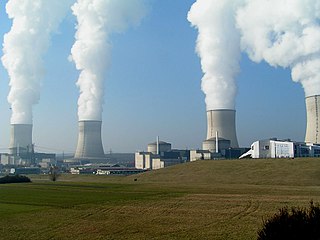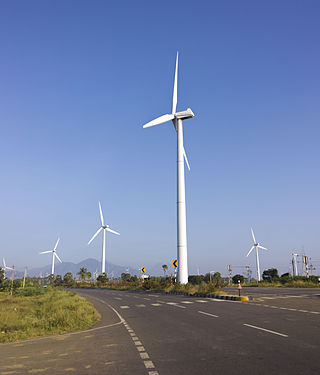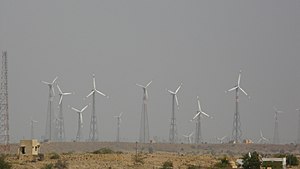
A wind farm or wind park, or wind power plant, is a group of wind turbines in the same location used to produce electricity. Wind farms vary in size from a small number of turbines to several hundred wind turbines covering an extensive area. Wind farms can be either onshore or offshore.

Iberdrola, S.A. is a Spanish multinational electric utility company based in Bilbao, Spain. It has around 40,000 employees and serves around 30 million customers.

Suzlon Energy is an Indian multinational wind turbine manufacturer headquartered in Pune.

The United Kingdom is the best location for wind power in Europe and one of the best in the world. The combination of long coastline, shallow water and strong winds make offshore wind unusually effective.

Many countries and territories have installed significant solar power capacity into their electrical grids to supplement or provide an alternative to conventional energy sources. Solar power plants use one of two technologies:

Wind power generation capacity in India has significantly increased in recent years. As of 30 September 2024, the total installed wind power capacity was 47.36 gigawatts (GW). India has the fourth largest installed wind power capacity in the world. Wind power capacity is mainly spread across the southern, western, and northwestern states. The onshore wind power potential of India was assessed at 132 GW with minimum 32% CUF at 120 m above the local ground level (agl). Whereas, the estimated potential at minimum 25% CUF is 695 GW at 120 agl.

In 2021 France reached a total of 18,676 megawatts (MW) installed wind power capacity placing France at that time as the world's seventh largest wind power nation by installed capacity, behind the United Kingdom and Brazil and ahead of Canada and Italy. According to the IEA the yearly wind production was 20.2 TWh in 2015, representing almost 23% of the 88.4 TWh from renewable sources in France during that year. Wind provided 4.3% of the country's electricity demand in 2015.

India is the world's 3rd largest consumer of electricity and the world's 3rd largest renewable energy producer with 46.3% of energy capacity installed as of October 2024 coming from renewable sources. Ernst & Young's (EY) 2021 Renewable Energy Country Attractiveness Index (RECAI) ranked India 3rd behind USA and China. In FY2023-24, India is planning to issue 50 GW tenders for wind, solar and hybrid projects. India has committed for a goal of 500 GW renewable energy capacity by 2030.

Wind power in Belgium has seen significant advancements, starting with the generation of electricity from offshore wind farms in 2009. By 2020, the capacity of these offshore farms reached 2,262 megawatts (MW), matching the combined output of Belgium's largest nuclear reactors, Doel 4 and Tihange 3. Concurrently, the development of on-shore wind energy, which remained minimal until 2004, experienced significant growth, with installed capacity and production doubling annually from 96 MW in 2004 to 2,476.1 MW by 2021. The percentage of electricity demand met by wind grew to about 14.4% by 2020.

As of January 2025, wind power in the Netherlands has an installed capacity of 11,714 MW, 40.5% of which is offshore. In 2022, the wind turbines provided the country with 18.37% of its electricity demand during the year. Windmills have historically played a major part in the Netherlands by providing an alternative to water driven mills.
In 2016, Arizona had 268 megawatts (MW) of wind powered electricity generating capacity, producing 0.5% of in-state generated electricity.

Enel Green Power S.p.A. is an Italian multinational renewable energy corporation, headquartered in Rome. The company was formed as a subsidiary of the power generation firm Enel in December 2008. It has operations in five continents generating energy from solar, geothermal, wind and hydropower sources. As of 2024, it manages a capacity of 64,7 GW, with an annual production of 114.22 TWh and has over 1300 plants worldwide.

The electricity sector in France is dominated by its nuclear power, which accounted for 71.7% of total production in 2018, while renewables and fossil fuels accounted for 21.3% and 7.1%, respectively. France has the largest share of nuclear electricity in the world, and together with renewable energy supplies, this has helped its grid achieve very low carbon intensity.

Walney Wind Farms are a group of offshore wind farms 9 miles (14 km) west of Walney Island off the coast of Cumbria, England, in the Irish Sea. The group, operated by Ørsted, consists of Walney Phase 1, Phase 2 and the Walney Extension. The extension has a capacity of 659 MW and it was the world's second largest offshore wind farm in 2018.

Wind power in Michigan is a developing industry. The industrial base from the automotive industry has led to a number of companies producing wind turbine parts in the state. The development of wind farms in the state, however, has lagged behind. In January 2021, there were a total of 1,481 wind turbines in the state with a nameplate capacity of 2,549 MW. The nameplate total exceeded 2,000 MW when Pine River came online in March 2019. Wind provided 4.2% of the state's electricity in 2016.

The Muppandal Wind Farm, located in Muppandal, Kanyakumari district, Tamil Nadu, is India's largest operational onshore wind farm. The project was developed by Tamil Nadu Energy Development Agency. The Muppandal Wind Farm's installed capacity is 1,500 MW, which makes it the 4th-largest operational onshore wind farm in the world.

Renewable energy in Taiwan contributed to 8.7% of national electricity generation as of end of 2013. The total installed capacity of renewable energy in Taiwan by the end of 2013 was 3.76 GW.

Wind power is a major industry in Taiwan. Taiwan has abundant wind resources however a lack of space on land means that most major developments are offshore.



















